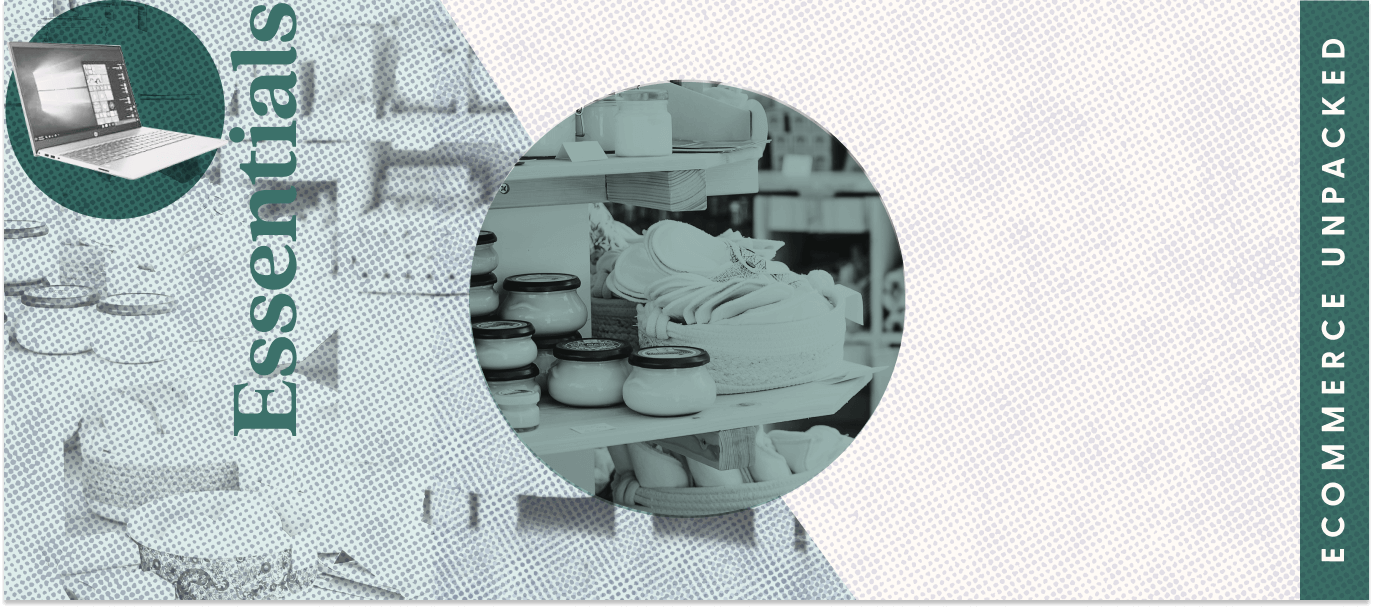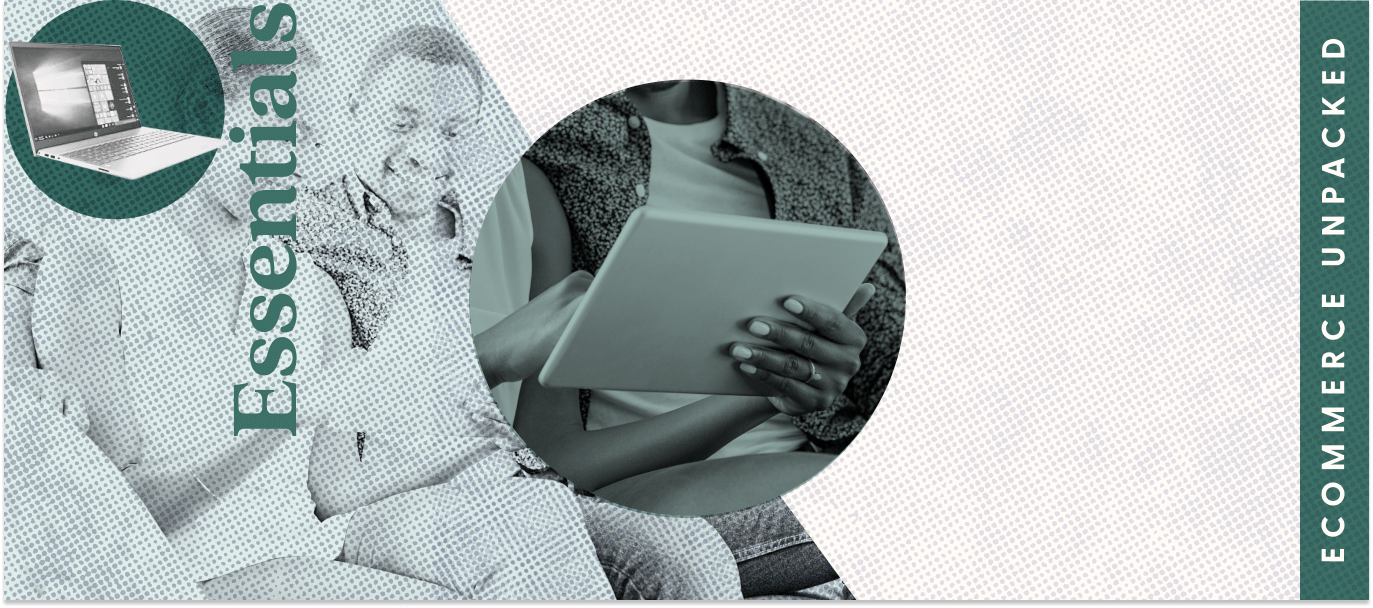The global mobile commerce market reached a value of $833.8 billion in 2021, and experts anticipate that market will grow to $4.71 trillion by 2027. As the rate of mobile online purchases continues to accelerate, mobile commerce becomes more and more vital for ecommerce businesses to leverage in strategic ways.
In this article, we’ll break down nine mobile commerce trends you can apply to your own business strategy in 2023.
Key takeaways
- Mobile commerce refers to the buying and selling of products and services via mobile devices, like smartphones.
- Mobile commerce trends include new technologies like augmented reality, voice shopping, intelligent chatbots, and progressive web apps.
- In 2023, focus on using m-commerce to improve convenience in the shopping experience by incorporating features like live shopping and one-click ordering, and building out a robust omnichannel retail strategy.
What is mobile commerce (m-commerce)?
Mobile commerce (m-commerce) is a form of ecommerce that is typically defined as the buying and selling of goods and services online via smartphones and tablets.
Popular m-commerce formats include:
Mobile shopping
In mobile shopping, transactions take place on smartphones through mobile-optimized websites. Companies using these techniques must ensure that online shopping is quick and easy with a connected device. This way, customers can purchase the products and services they need at any time, whether or not they have access to a desktop computer.
An m-commerce transaction might take place via a social media platform. For example, a user might see a beautiful pair of shoes on Instagram and tap a link to buy them. Curalate reports that 76% of consumers have purchased items they’ve seen in social media posts, proving just how powerful and popular mobile shopping can be.
Mobile banking
More than 75% of Americans have connected with their banks via a mobile app, Forbes reports. Some may have started the practice during the pandemic when banks were unavailable. Others simply liked the convenience of banking without an in-person visit.
This is the value of mobile banking, which allows mobile users to track their credit cards, transfer money, make payments, and more by using their smartphones and connected devices. This increases the flexibility, convenience, and speed of the banking process for users, improving the overall customer experience.
Mobile payments
Mobile payments solutions allow users to make payments for goods and services right from their mobile device, without needing to handle cash. Mobile payments can be made both in brick-and-mortar stores and online.
Mobile payment options include:
- Digital wallets connected to credit cards or bank accounts
- Sites like PayPal that work as intermediaries for online sales
- QR codes that connect to sites like Stripe for payments
Speed is the primary benefit of mobile payment and mobile wallet solutions. Online shoppers and some visitors to physical stores can pay by flashing their phones or tapping in a simple code.
9 mobile commerce trends to follow in 2023
Understanding mobile and apps commerce trends can help you respond to changing customer demands, ensuring that you’re delivering experiences that surprise and delight.
Now, let’s explore nine trends in mobile commerce to watch in the coming years.
1. Augmented reality
Augmented reality has the potential to transform the ecommerce industry in new and exciting ways. Do it well, and you could reduce your cart abandonment rate and give your customers a strong understanding of your products and services before they buy.
Consider Wayfair’s View in Room. This innovative augmented reality tool allows customers to visualize what a product would look like inside their homes. Consumers can place an item in its intended space, and they can stand in front of it to see what it looks like at scale. View in Room also includes some gamification, so chairs can hover over the ground or sprout from the ceiling.
Tools like this offer customers an immersive and convenient experience, enabling them to interact in real time with a company’s products and services without having to leave their homes.
2. Visual commerce
Online shopping almost always involves photos—after all, customers typically need to see your products before they buy them. But visual commerce tools give these images new life through unexpected angles, virtual reality tools, or both.
Your visual commerce strategy might involve the following:
- Experimentation: Allow customers to edit the color or design of your product and see how that changes the experience or desirability.
- Augmented reality: Let customers see what your products look like on their bodies or in their homes.
- 3D visualization: Let customers examine every inch of your product, twisting and turning it as they see fit.
Social media sites like TikTok and Instagram have helped popularize this concept. Now, many people consider it an integral part of the customer experience for mobile users.
3. Social commerce
Studies show that more than 4.74 billion people use social media sites globally. Social commerce involves grabbing users’ attention on mobile devices via social media sites like Instagram, TikTok, or Facebook and enticing those potential customers to buy a product or service.
Today, social media platforms come with many m-commerce integrations, making it easier than ever to share a product link on these sites. When customers have the ability to use their digital wallets to pay on top of this, the process of shopping through social media is made even faster and more convenient.
4. Voice shopping
Today, voice search technology is relatively commonplace. Instead of reaching for our phones to answer questions (like “How hot is it outside?”), we can just speak the query aloud and get an immediate answer. That same technology can be incorporated into m-commerce to further increase convenience and flexibility.
For example, a voice search about a product could lead a customer to shopping apps, and a few spoken commands could help the customer complete the purchase.
5. Intelligent chatbots
If your customers ask the same questions repeatedly, and you’re unable to provide around-the-clock customer service support, intelligent chatbots that are compatible with mobile devices may be a helpful solution for your business.
Chatbots use AI to understand and learn from human speech patterns. Each time they talk to customers, they learn from them. They can also complete common customer requests, such as initiating returns or handling payment problems.
6. Omnichannel retail
Your business may offer both ecommerce and in-store experiences. Loyal customers expect a consistent shopping and brand experience in both environments.
Omnichannel retail techniques do more than match colors and logos on different channels. They streamline the checkout process, ensuring customers can use the same payment methods in both environments. They allow a coupon’s use in multiple places. And they allow customers to start a purchase online and finish it by picking it up in the store.
7. One-click ordering
With one-click ordering, customers don’t need to complete screens involving billing and shipping. Instead, with one tap, they can complete the purchase.
Applying this technique could vastly increase your conversion rate. The more you reduce friction in the buying process, the less likely it is that your potential customers will back out before paying.
8. Progressive web apps
You can use the same technology you’d lean on to build a website and create something that feels and works like an app instead.
A main benefit of a progressive web app is that it works whether or not customers have a reliable internet connection. And progressive web apps load incredibly quickly, so customers don’t have to wait for them.
9. Live shopping
Use live shopping to show customers on a livestream what a product or service looks like in real-time as they follow along on their smartphones.
You can use live shopping techniques on social media sites, but some companies also hold exclusive online events with live shopping opportunities.
Key mobile commerce benefits
By paying attention to the trends we’ve just highlighted, you can capture some of the main benefits of focusing on mobile commerce. These benefits include:
Personalized customer experience
Forbes reports that more than 50% of all customers expect company offers to be personalized. With mobile commerce, you can tap into a user’s browsing history, purchase data, and demographic information to deliver a completely customized experience.
Seamless browsing & purchasing
Consumers want a frictionless experience, whether they’re shopping in person or online. Mobile users may want to look at a product on their phones while they’re standing in front of it in a store to access more information about it.
Ecommerce allows customers to browse a product’s colors, sizes, and upgrades quickly and easily. If they choose to pop the product in a virtual shopping cart, they can complete the transaction quickly and easily.
Flexible digital payment options
“Cash or credit?” Customers once faced these two simple payment choices. Now, online shopping can mean paying for products with a digital wallet, Venmo, PayPal, and more.
Payment flexibility reduces a customer’s purchase resistance. When they can pay for something in multiple ways, they’re more likely to complete the transaction.
Better mobile checkout flow
Almost 70% of online shopping carts are filled and never pushed through checkout, according to Baymard.
M-commerce apps and seamless payment solutions can help lower abandonment rates and increase potential revenue. They allow customers to tap an online wallet rather than inputting every credit card number by hand. And they can finish the process on their phones rather than waiting to head into the office to finish the purchase on a desktop.
(Nearly) instant customer feedback
It’s critical to understand how your customers feel about your ecommerce business and brand. Mobile commerce techniques can keep you in close contact with the people who matter the most.
Shopping apps with chatbots can help you solve problems quickly, while online rating tools let customers tell you about their shopping experience. This can help you collect valuable feedback more quickly, regularly, and effectively.
Enhanced customer support systems
In a perfect world, mobile commerce sales would always be frictionless and quick. In reality, customers might encounter problems with your product or fulfillment regardless of the strategies that you use. However, with mobile commerce, you have a unique advantage in the ability to research and solve those problems quickly.
Mobile commerce chatbots and automation let you tap into machine learning to solve customer complaints and concerns. The increased connectivity that mobile commerce creates can lead to an enhanced customer support experience.
FAQs on mobile commerce trends
What are the challenges in mobile commerce?
Many m-commerce challenges are similar to those of ecommerce in general. These challenges may include:
- Size constraints: Smartphones have small screens compared to desktop computers. While photography is critical, images might need to meet certain size requirements to accommodate this format.
- Platform changes: Mobile devices vary by their manufacturer and operating system. Strategies that work well on one smartphone may not function exactly the same way on another.
- Typing challenges: Shopping experiences often require customers to type to make searches and find products or services. Depending on the device, typing may be slightly less convenient on a mobile device than on a desktop.
How can I design effective mobile commerce applications?
Creating mobile apps and m-commerce tools takes time and expertise. Consider working with a development team with plenty of ecommerce business experience, and ask for demonstrations on mobile phones.
Sources
[1] Unpacking Ecommerce (OECD iLibrary)
[2] Ecommerce in the Time of COVID-19 (OECD)
[3] M-commerce (Mobile Commerce) (TechTarget)
[4] Behind the Growth of Mobile Commerce (Forbes)
[5] Global Mobile Commerce Market (2022 to 2027): Industry Trends, Share, Size, Growth, Opportunity and Forecasts (BusinessWire)
[6] 76% of Consumers Buy Products Seen in Social Media Posts ( Retail Touch Points)
[7] Digital Banking Survey: 76% Of Americans Bank Via Mobile App — Here Are the Most And Least Valuable Features (Forbes)
[8] What Does Today's Consumer Want? Personalized, Seamless, Omnichannel Experiences (Forbes)
[9] 48 Cart Abandonment Rate Statistics 2022 (Baymard Institute)
[10] Augmented Reality with a Purpose (Wayfair)
[11] Global Social Media Statistics (DataReportal)
[12] Why Amazon's 1-Click Ordering Was a Game Changer (Knowledge at Wharton)
[13] 6 Important Types of M-Commerce Services and Applications (Tech Funnel)
[14] Mobile Commerce Is the Under-The-Radar Story In Consumers’ Flight to Digital Shopping (Forbes)



